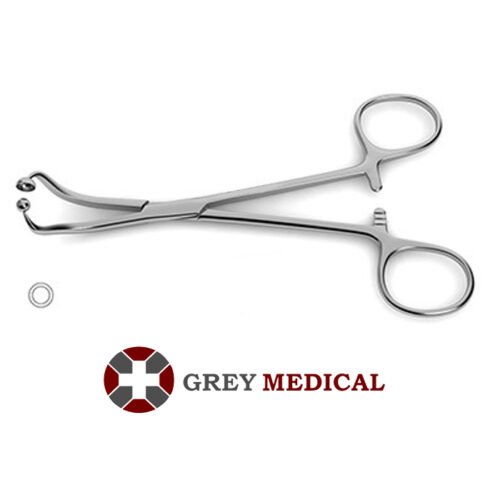Clamp Socket: A Critical Component for Secure Instrument Handling in Surgical Settings
The clamp socket is an indispensable accessory in surgical practice, providing secure and stable positioning of instruments during a wide range of procedures.
The clamp socket is a small yet vital surgical accessory used to securely hold and stabilize clamps or other surgical instruments during procedures. Its primary function is to provide a reliable connection point for clamps, ensuring they remain fixed in the desired position throughout an operation. Clamp sockets are essential for maintaining precision and efficiency in the operating room, especially during procedures requiring hands-free stabilization of instruments.

Design and Features of the Clamp Socket
Clamp sockets are designed for versatility, durability, and reliability, allowing them to meet the rigorous demands of surgical procedures. Their design includes the following key features:
1. Universal Fit
Many clamp sockets are designed to accommodate a wide range of clamps and surgical instruments, making them versatile tools in the operating room.
2. Locking Mechanism
Clamp sockets often include a secure locking mechanism, such as a screw or quick-release system, to hold instruments firmly in place. This prevents slippage and ensures stability during surgery.
3. Durable Materials
Constructed from high-quality materials such as surgical-grade stainless steel or reinforced plastics, clamp sockets are built to withstand repeated use, sterilization, and exposure to various surgical environments.
4. Compact and Ergonomic Design
The compact size of clamp sockets ensures they do not interfere with the surgical field, while their ergonomic design allows for easy attachment and adjustment.
5. Adjustable Angles
Some clamp sockets are equipped with adjustable joints or swivels, enabling surgeons to position instruments at precise angles for optimal access to the surgical site.
Applications of Clamp Sockets
Clamp sockets play a vital role in various medical and surgical applications. Their primary uses include:
1. Instrument Stabilization
Clamp sockets are used to secure surgical instruments such as retractors, clamps, or endoscopic tools in a fixed position, freeing up the surgeon's hands for other tasks.
2. Surgical Field Organization
By holding instruments in place, clamp sockets help maintain an organized surgical field, reducing clutter and improving workflow during complex procedures.
3. Microsurgery
In delicate microsurgical procedures, clamp sockets provide the precision and stability required to hold instruments without hand tremors or movement.
4. Diagnostic Procedures
Clamp sockets are often used in diagnostic setups, such as securing imaging or endoscopic equipment for steady and accurate visualization of internal structures.
5. Veterinary Medicine
Clamp sockets are also widely used in veterinary surgeries to stabilize instruments during procedures on animals of various sizes.
Advantages of Clamp Sockets
1. Hands-Free Operation
Clamp sockets allow surgical teams to stabilize instruments without the need for continuous manual handling, improving efficiency and focus during procedures.
2. Precision and Stability
The locking mechanism ensures that instruments remain securely in place, even during lengthy or complex surgeries, enabling surgeons to work with precision.
3. Versatility
Clamp sockets can be used with a variety of instruments, making them a flexible solution for different surgical applications and procedures.
4. Enhanced Safety
By securely holding instruments, clamp sockets minimize the risk of accidental slips or movements that could harm the patient or disrupt the procedure.
5. Durability
Made from high-quality materials, clamp sockets are designed for repeated use in demanding surgical environments, ensuring long-term reliability.
Care and Maintenance of Clamp Sockets
Proper care and maintenance are essential to ensure the performance and longevity of clamp sockets:
1. Cleaning
Clean the clamp socket thoroughly after each use to remove blood, tissue, or debris. Use appropriate cleaning solutions to prevent corrosion or damage to the material.
2. Sterilization
Sterilize the clamp socket using standard procedures, such as autoclaving, to ensure it is safe for use in subsequent surgeries.
3. Inspection
Regularly inspect the socket for signs of wear, such as loose locking mechanisms or damaged components. Replace or repair the socket if necessary to maintain safety and functionality.
4. Storage
Store the clamp socket in a clean, dry environment, ideally in a designated surgical tray or instrument organizer, to protect it from contamination or physical damage.
Conclusion
The clamp socket is an indispensable accessory in surgical practice, providing secure and stable positioning of instruments during a wide range of procedures. Its versatility, precision, and durability make it a critical component for maintaining an organized and efficient surgical field. From stabilizing retractors to holding endoscopic equipment, clamp sockets play a vital role in enabling surgeons to perform with confidence and accuracy.
By investing in high-quality clamp sockets and adhering to proper care and maintenance protocols, surgical teams can ensure consistent performance and optimal patient outcomes. As a cornerstone of modern surgical instrumentation, the clamp socket continues to enhance efficiency, safety, and precision in the operating room.

 GreyMed
GreyMed